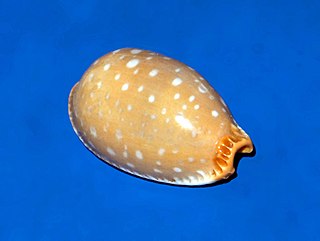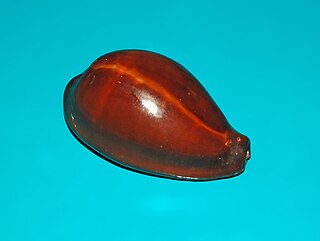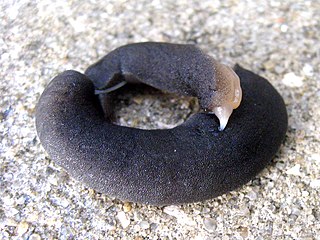
The decollate snail, scientific name Rumina decollata, is a medium-sized predatory land snail, a species of terrestrial pulmonate gastropod mollusk in the family Achatinidae. It is a European species that has been introduced in a number of areas worldwide.

The African armyworm, also called okalombo, kommandowurm, or nutgrass armyworm, is a species of moth of the family Noctuidae. The larvae often exhibit marching behavior when traveling to feeding sites, leading to the common name "armyworm". The caterpillars exhibit density-dependent polyphenism where larvae raised in isolation are green, while those raised in groups are black. These phases are termed solitaria and gregaria, respectively. Gregaria caterpillars are considered very deleterious pests, capable of destroying entire crops in a matter of weeks. The larvae feed on all types of grasses, early stages of cereal crops, sugarcane, and occasionally on coconut. The solitaria caterpillars are less active and undergo much slower development. The species is commonly found in Africa, but can also be seen in Yemen, some Pacific islands, and parts of Australia. African armyworm outbreaks tend to be devastating for farmland and pasture in these areas, with the highest-density outbreaks occurring during the rainy season after periods of prolonged drought. During the long dry seasons ("off-season"), the population densities are very low and no outbreaks are seen.

Laevicaulis alte, or the tropical leatherleaf, is a species of tropical land slug, a terrestrial pulmonate gastropod mollusk in the family Veronicellidae, the leatherleaf slugs.

The Systellommatophora is a clade of primitive, air-breathing slugs, according to the taxonomy of the Gastropoda.

Eleutherocaulis haroldi, known as Purcell's hunter slug or the caterpillar slug, is a species of tropical land slug in the family Veronicellidae, the leatherleaf slugs. It was first formally named Laevicaulis haroldi in 1980.
Thapsia buraensis is a species of air-breathing land snail or semi-slug, a terrestrial pulmonate gastropod mollusk in the family Urocyclidae.

The Veronicellidae, also known by their common name the leatherleaf slugs, are a family of pulmonate terrestrial slugs.
Micractaeon koptawelilensis is a species of land snail, terrestrial gastropod mollusks in the superfamily Achatinoidea.

Veronicella sloanii, commonly called the pancake slug, is a species of air-breathing land slug, a terrestrial, pulmonate gastropod mollusk in the family Veronicellidae, the leatherleaf slugs.

Ambigolimax valentianus is a species of terrestrial slug, a pulmonate gastropod mollusc in the family Limacidae. It has spread very widely around the world, especially in greenhouses, where it can be a pest; in warmer climates it has often then spread outdoors. Comparatively much has been learnt about its life cycle and temperature relations. Dissection is necessary to reliably distinguish it from congeners in regions where these co-occur.

Erronea onyx, common name the onyx cowry, is a species of sea snail, a cowry, a marine gastropod mollusk in the family Cypraeidae, the cowries.

Mauritia histrio, common name the harlequin cowry or the stage cowry, is a species of sea snail, a cowry, a marine gastropod mollusk in the family Cypraeidae, the cowries.

Staphylaea limacina, common name slug-like cowry, is a species of sea snail, a cowry, a marine gastropod mollusk in the family Cypraeidae, the cowries.
Bulinus nasutus is a species of tropical freshwater snail with a sinistral shell, an aquatic gastropod mollusk in the family Planorbidae, the ramshorn snails and their allies.

Erronea adusta, common name the chocolate beauty or tanned/dark onyx cowry, is a species of sea snail, a cowry, a marine gastropod mollusk in the family Cypraeidae, the cowries. This species was formerly regarded as a subspecies of the onyx cowry.

Vigna parkeri, the creeping vigna or vigna menjalar, is a climbing or prostrate perennial vine that grows in subtropical areas such as Kenya, Indonesia, and Madagascar.

Belocaulus angustipes, the black-velvet leatherleaf slug, is a species of land slug in the family Veronicellidae native to South American tropical regions.













